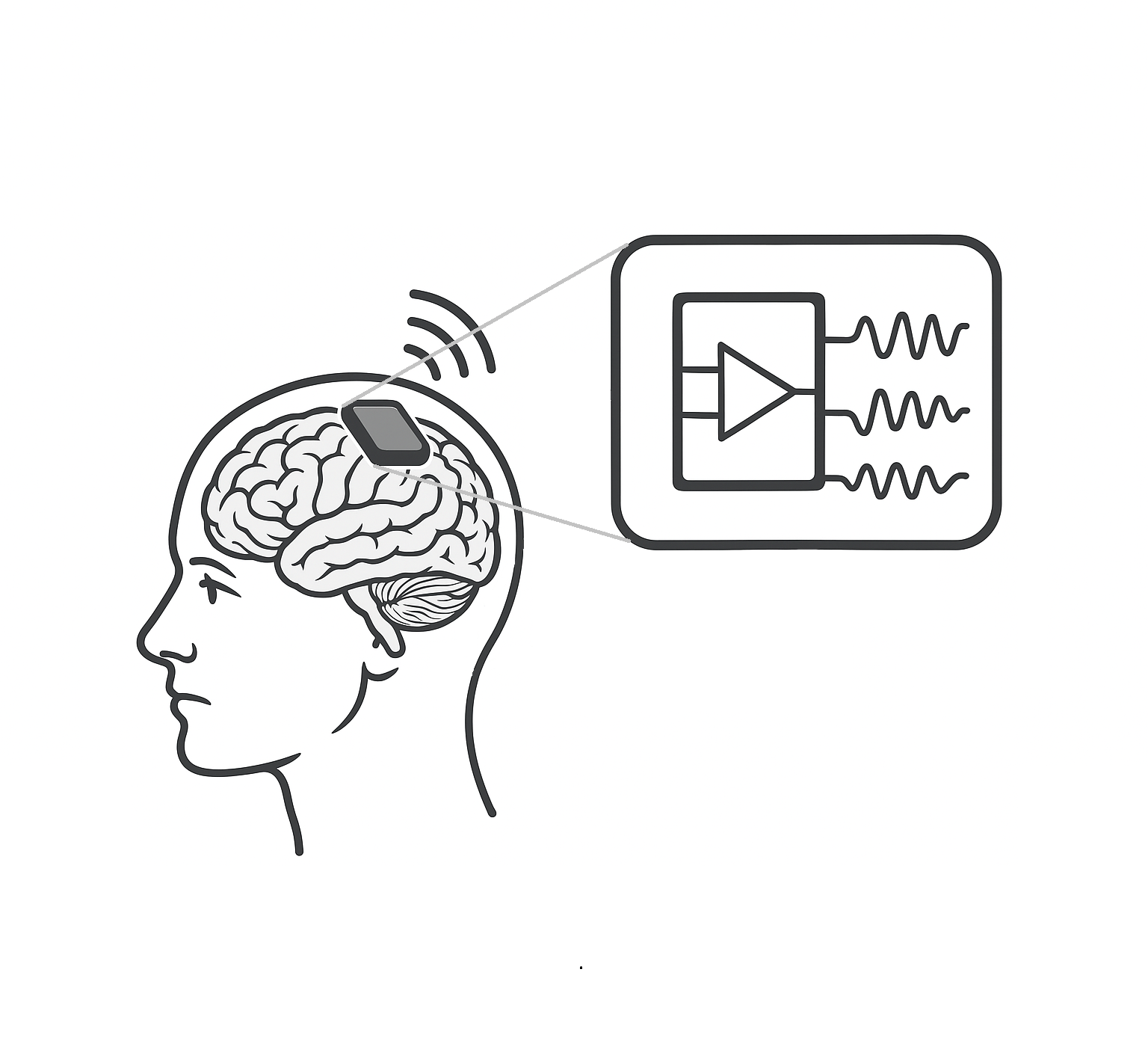Neural Recording Front-Ends for Implantable Brain-Computer Interfaces
Why it matters
Implants that both sense and stimulate must capture micro‑volt neural spikes and milli‑volt stimulation artifacts on the same electrodes, without clipping, aliasing, or draining the tiny power budget. As channel counts soar, designers must deliver >100 dB dynamic range, μW‑level power, and real‑time compression so data can escape the skull.
Our approach
High‑DR ADC‑at‑electrode architectures with charge‑balancing front stages that survive kilo‑hertz stimulation pulses.
Adaptive sensing & compressive sampling—the front end selects resolution and sample rate on the fly, streaming only what matters and slashing data volume by up to 20×.
Artifact‑resilient signal paths that settle in <1 ms after a stimulation burst, enabling true closed‑loop neuromodulation.
Who should care
ASIC & mixed‑signal grad students – Tape‑out chips, bench‑test DR and artifact recovery, validate in vivo.
Neuromodulation researchers – Merge recording and stimulation in a single probe for next‑gen therapies.
Medical‑device firms – Licensing and consulting for FDA‑grade implant front‑ends.
ISSCC is the highest-ranked conference in the field of integrated circuits.
Artifact-Resilient EEG Recording for Outpatient and Wearable Applications
CICC is a premier conference in the field of solid-state circuits.
Why it matters
Real‑world EEG must survive head motion, hair, sweat, and daily life—no gooey gels, no lab tether. Dry electrodes boost comfort but impose mega‑ohm impedance and huge motion artifacts, exactly where traditional EEG amps fall apart.
Our approach
Ultra‑high‑Zin, high‑DR front‑ends that maintain sub‑µV noise even with dry‑skin contact.
On‑chip motion‑artifact detection & hybrid removal—inertial sensors and adaptive filters cancel blinks, jaw clench, and cable tug in real time.
System‑level co‑design of electrode materials, flex‑PCBs, batteries, and wireless links to keep the headset light, stylish, and clinic‑grade.
User‑centered integration—snap‑fit modules and quick‑charge cradles that make multi‑hour recordings effortless for patients and researchers.
Who should care
EE/CE grads – Build and test full wearable stacks from electrode to smartphone app.
Sleep & movement‑disorder labs – Collect high‑quality home EEG without technician setup.
Consumer neurotech startups – Drop‑in analog‑front‑end IP, motion‑artifact firmware, and design guidance.
On-Chip Signal Processing and Machine Learning for Biomedical Signals
Why it matters
Streaming every raw sample burns batteries and adds latency. Closed‑loop neuromodulation needs decisions inside the implant and within milliseconds.
Our approach
Neuromorphic spike encoders, analog‑digital hybrids, and tiny CNN accelerators that sort spikes, detect seizures, or classify tremor patterns on <1 mW.
Context‑aware precision scaling—the chip spends picojoules during idle periods and full horsepower only when physiology gets interesting.
Modular IP for EEG, ECG, EMG, and disease‑specific classifiers.
Who should care
ML‑savvy grads – Train models, map them to silicon, validate in vivo.
Neuroscientists – Real‑time biomarkers without a tethered workstation.
Med‑tech companies – Upgrade your device to “smart” with proven edge‑AI blocks.
Responsive Neurostimulation: Electrical and Optical Modalities
Why it matters
The brain changes second‑to‑second; fixed‑pattern stimulation can miss the window—or worse, over‑stimulate.
Our approach
Adaptive electrical drivers with dynamic compliance and per‑channel pulse shaping for safe, precise charge delivery across variable impedances.
Implantable micro‑LED arrays for cell‑type‑selective optogenetics, coupled with on‑chip temperature and light‑dose monitors.
Closed‑loop controllers that read neural feedback and tweak stimulation on the fly.
Who should care
Clinical researchers – Test new biomarkers and therapy paradigms without rebuilding hardware.
Optogenetics labs – High‑density light delivery plus concurrent recording in a single implant.
Device manufacturers – Multimodal IP blocks ready for FDA‑class systems.
BioCAS is the flagship conference in biomedical circuits & Systems.
Wireless Data Communication for Miniaturized Neurodevices
Why it matters
More channels = more bits. But RF power budgets in tissue are tight, and regulatory limits are non‑negotiable.
Our approach
Custom UWB and sub‑GHz FSK links tuned for brain‑tissue paths, delivering Mbps at microwatts.
Cross‑layer duty‑cycling that syncs radios with local data buffers and power receivers, cutting idle leakage to near‑zero.
Interference‑resilient framing compliant with medical EMI standards.
Who should care
Start‑ups – Integrate secure, high‑throughput telemetry without RF black magic.
IoT researchers – Study brain data streaming alongside wearables and home hubs.
Standards bodies – Collaborate on future medical UWB specs.
ISCAS is the flagship conference of IEEE Circuits and Systems society.
Wireless Power Transfer and Management
Why it matters
No one wants repeat surgeries for battery swaps. Yet coil misalignment, tissue absorption, and burst‑mode stimulators wreak havoc on power links.
Our approach
Adaptive inductive and ultrasonic links that sense coupling conditions and retune frequency, Q‑factor, or drive strength in real time.
Conduction‑angle modulation and load‑link isolation that keep end‑to‑end efficiency >70 % across head movement.
Smart energy buffers—super‑capacitor interfaces that juggle charge‑and‑fire loads without voltage droop.
Who should care
Implant makers – Battery‑free designs that meet IEC/ISO safety limits.
System integrators – Co‑designed power & data links that share antennas and silicon.
Graduate students – Experiment with live wireless‑power testbeds and custom ASIC controllers.






